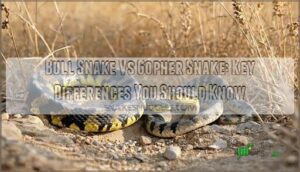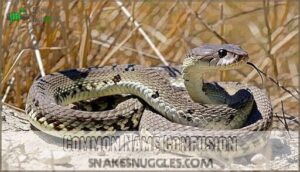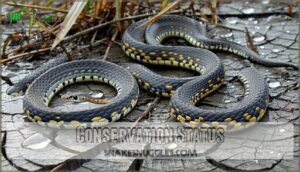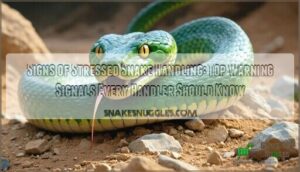This site is supported by our readers. We may earn a commission, at no cost to you, if you purchase through links.
 Here’s the truth about bull snake vs gopher snake differences: you’re actually looking at the same species wearing different name tags.
Here’s the truth about bull snake vs gopher snake differences: you’re actually looking at the same species wearing different name tags.
Both are subspecies of Pituophis catenifer, so there’s no real biological difference between them.
The "bull snake" name typically refers to larger, Great Plains populations, while "gopher snake" describes western varieties.
You’ll notice slight variations in size and color patterns based on their geographic location, but they’re basically cousins at the family reunion.
Think of it like comparing a New Yorker to a Texan – same species, different regional flair.
Understanding their shared identity reveals fascinating insights about adaptation and survival strategies.
Table Of Contents
- Key Takeaways
- Distribution and Range
- Physical Characteristics
- Habitat and Behavior
- Common Name Confusion
- Conservation Status
- Frequently Asked Questions (FAQs)
- What is the Difference in Size Between Bull Snakes and Gopher Snakes?
- What is the Typical Diet of Bull Snakes and Gopher Snakes?
- How Do Bull Snakes and Gopher Snakes Defend Themselves?
- What Are the Geographical Ranges of Bull Snakes and Gopher Snakes?
- How do you tell the difference between a gopher snake and a bull snake?
- How do you tell if it’s a gopher snake?
- Can a bull snake hurt you?
- How poisonous is a gopher snake?
- What do bull snakes and gopher snakes eat?
- How long do these snakes typically live?
- Conclusion
Key Takeaways
- You’re actually looking at the same species – both bull snakes and gopher snakes are subspecies of Pituophis catenifer, so there’s no real biological difference between them.
- You’ll notice bull snakes are typically larger (up to 8 feet) with brighter coloration and dominate the central U.S., while gopher snakes are smaller (4-6 feet) with more muted tones and live in western regions.
- You can identify them by their scale patterns – bull snakes have smooth scales and blunt noses, while gopher snakes feature keeled scales and pointed noses.
- You’ll find both species are nonvenomous constrictors that share identical behaviors, diets, and ecological roles, with their slight differences simply reflecting local environmental adaptations.
Distribution and Range
In the vast expanse of the Western Territories, bull snakes and gopher snakes have distinct yet overlapping geographic ranges.
Bull snakes, a subspecies of gopher snakes, dominate the central U.S., stretching into Canada and Mexico, with their range halting in West Texas and eastern New Mexico.
Bull snakes rule the heartland—from Canadian prairies to Mexican borderlands, but stop short of the Southwest.
However, if you’re exploring Arizona’s coastal regions or open landscapes, you’ll only encounter gopher snakes. The state hosts two regional variations: Sonoran and Great Basin gopher snakes.
These subspecies thrive in desert habitats and prefer arid conditions. Understanding snake distribution highlights their habitat preferences—bull snakes favor the plains, while gopher snakes spread widely across western and southwestern North America.
Geographical ranges reveal their fascinating adaptability! Similarly, the black mamba favors savannas and woodlands.
Physical Characteristics
Bull snakes and gopher snakes share many traits, but their differences make identification easier.
Pay attention to these details:
- Scale patterns: Bull snakes have a blunt nose and smooth, heavy scales, while gopher snakes feature keeled scales and a pointed nose.
- Body size: Bull snakes grow up to 8 feet, but gopher snakes typically max out at 6 feet.
- Color variations: Bull snakes are brown; gopher snakes sport yellow, cream, or gray tones with dark blotches.
- Markings differences: Gopher snakes’ blotches are reddish-brown or black.
Their flexible bodies facilitate serpentine style movement.
Habitat and Behavior
Regarding habitat and behavior, bull snakes and gopher snakes share a lot in common, yet there are some interesting differences.
These fascinating serpents are master adapters, thriving in diverse landscapes while maintaining remarkably similar lifestyles.
Both species thrive in sandy, open areas with loose, well-drained soil, making these regions prime bull snake and gopher snake habitats.
They exhibit fascinating burrowing habits, often using abandoned rodent tunnels or creating their own.
Their activity patterns show they’re active by day, primarily from spring through fall, and go underground to hibernate during colder months.
In terms of diet variation, these snakes excel as natural pest controllers by feeding on gophers, mice, birds, eggs, and even squirrels.
Predator avoidance is an art for both species—they hiss, vibrate their tails, and might fake aggression like a rattlesnake.
Although they’re mostly solitary, these snakes share a surprising ability to adapt to human-altered environments, balancing ecosystems with ease.
These snakes exhibit various camouflage techniques to evade predators and ambush prey.
Common Name Confusion
You’ll often encounter confusing name origins when identifying these serpents. Regional variations create significant taxonomic ambiguity that affects public perception and increases misidentification risks.
Here’s what complicates bull snake vs gopher snake identification:
- Snake identification becomes tricky when "bullsnake" refers to Pituophis catenifer sayi specifically
- Eastern regions favor "bull snake" while western areas use "gopher snake"
- Both terms describe the same species in many locations
- Snake comparison requires understanding local naming conventions
This bull snake identification versus gopher snake identification confusion stems from overlapping ranges and similar appearances. These snakes exhibit defensive mimicry tactics when threatened.
Conservation Status
Both species face different conservation challenges that you should understand.
Bull snakes are listed as "least concern" globally but face regional threats, while Pacific gopher snakes struggle with habitat loss and road mortality in some areas.
Conservation Status highlights:
- Bull snakes are considered sensitive species in Alberta with declining populations
- Gopher snakes rank as "least concern" but face habitat destruction threats
- Road mortality poses significant risks to both species’ survival
- Habitat Loss from urban sprawl threatens snake conservation efforts
Population Trends show mixed results across regions, making Bullsnake Protection and Conservation Efforts increasingly important.
Conservation efforts are also essential due to groundwater depletion threats.
Frequently Asked Questions (FAQs)
What is the Difference in Size Between Bull Snakes and Gopher Snakes?
You’ll notice bullsnakes typically grow larger, reaching up to 8 feet in length, while gopher snakes usually max out at 4-6 feet.
Bullsnakes also appear bulkier and more robust compared to gopher snakes’ slender proportions.
What is the Typical Diet of Bull Snakes and Gopher Snakes?
These powerful hunters absolutely devour rodents like gophers, mice, rats, and ground squirrels.
You’ll find they’re nature’s pest control experts, occasionally grabbing bird eggs, small birds, and even other snakes when opportunity strikes.
How Do Bull Snakes and Gopher Snakes Defend Themselves?
When you encounter these snakes, they’ll coil up, hiss loudly, and vibrate their tails like rattlesnakes.
They’ll puff up their bodies, strike defensively, and release a musky scent to deter predators effectively.
What Are the Geographical Ranges of Bull Snakes and Gopher Snakes?
You’ll find bull snakes roaming central and southern United States territories.
While gopher snakes dominate western regions from southwestern Canada through Pacific states to northern Mexico, with some overlap in southwestern areas.
How do you tell the difference between a gopher snake and a bull snake?
You’ll spot bull snakes by their brighter coloration and larger size—they can reach 8 feet compared to gopher snakes’ 4-6 feet.
Bull snakes also display more vibrant skin tones while gopher snakes appear more muted.
How do you tell if it’s a gopher snake?
Like reading nature’s blueprint, you’ll recognize a gopher snake by its slender 4-6 foot body, creamy yellow or tan coloring with dark brown blotches.
It has a preference for rocky, arid western habitats from Canada to Mexico.
Can a bull snake hurt you?
Bull snakes can’t hurt you with venom since they’re nonvenomous constrictors.
However, they’ll bite defensively if threatened, causing minor puncture wounds.
Their impressive hissing and striking display is mostly bluff to scare off potential threats, which can be seen as a form of defensive behavior.
How poisonous is a gopher snake?
Gopher snakes aren’t poisonous at all—they’re completely nonvenomous constrictors.
You won’t face any toxic effects if bitten, though their defensive strikes might cause minor puncture wounds that need basic first aid care.
What do bull snakes and gopher snakes eat?
These powerful constrictors hunt primarily rodents like mice, rats, gophers, and ground squirrels.
They’ll also consume birds, eggs, and occasionally rabbits.
You’ll find them actively hunting both day and night, using their keen senses.
How long do these snakes typically live?
Seasoned hikers know that snakes outlive many household pets. You’ll discover these remarkable constrictors living 12-20 years in wild conditions, while captive specimens often reach 25-30 years with proper care.
Conclusion
Surprisingly, when you’re debating bull snake vs gopher snake what’s the difference, you’re actually comparing regional variations of the same species.
These Pituophis catenifer subspecies showcase nature’s remarkable adaptability across different environments.
You’ll find they share identical behavioral patterns, dietary preferences, and ecological roles despite their geographic separation.
Their slight physical variations simply reflect local environmental pressures rather than fundamental biological differences.
Understanding this connection helps you appreciate how one species can successfully colonize diverse habitats while maintaining its core identity.
- http://www.californiaherps.com/snakes/maps/xpcateniferspeciesmap3.jpg
- https://www.terminix.com/blog/science-nature/identify-types-of-gopher-snakes/
- https://en.wikipedia.org/wiki/Bullsnake
- https://reptilesmagazine.com/gopher-snake-care-and-breeding-information/?srsltid=AfmBOooiruGnczjKsCpTC_uJLe01VNfSpaG09J-jbae84fvL43Kbpnb1








